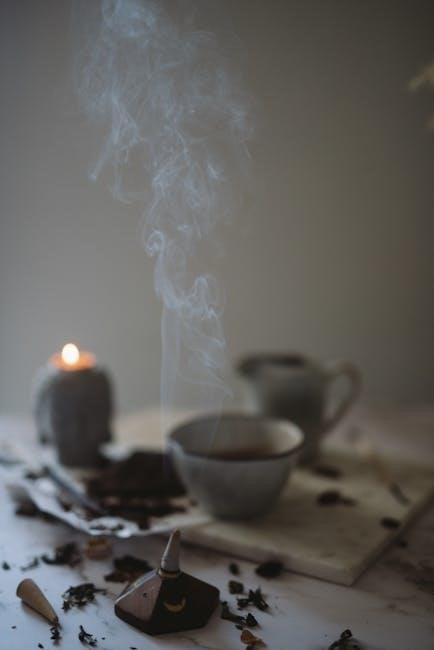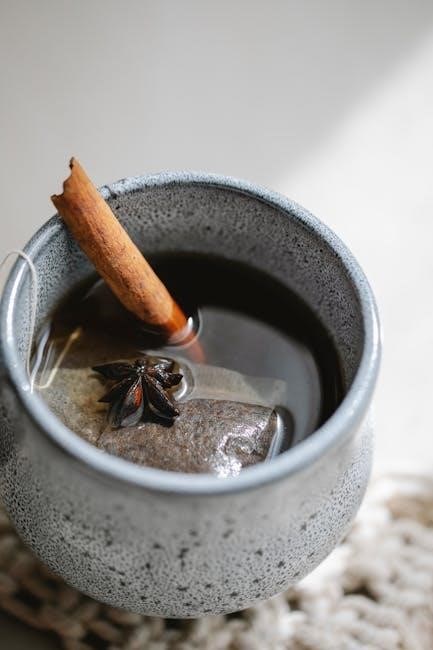Herbal tea‚ a caffeine-free infusion of herbs‚ flowers‚ and spices‚ has been enjoyed globally for centuries‚ promoting wellness and cultural rituals‚ offering a soothing‚ natural way to unwind and rejuvenate.
What is Herbal Tea?
Herbal tea‚ also known as tisane‚ is a caffeine-free beverage made by infusing herbs‚ flowers‚ fruits‚ and spices in hot water. Unlike traditional tea from Camellia sinensis‚ it offers diverse flavors and potential health benefits. Popular options include peppermint‚ chamomile‚ and hibiscus‚ each with unique characteristics. Preparation methods vary‚ with steeping times and water temperatures affecting flavor and nutrient extraction. Culturally significant‚ herbal teas are integral to traditions worldwide‚ such as maté in South America and rooibos in South Africa. While generally safe‚ individuals with allergies or health conditions should exercise caution. Herbal teas provide a natural‚ soothing alternative to conventional teas‚ with a rich history rooted in medicinal and ritualistic use.
Brief History of Herbal Tea
Herbal tea has a rich history dating back thousands of years‚ with origins in ancient Egypt‚ China‚ and Rome. Egyptians used herbal infusions for medicinal and religious purposes‚ while Chinese herbalism dates to the Shang Dynasty‚ where herbs were used in rituals and healing. Greek physicians like Hippocrates and Dioscorides documented herbal remedies‚ which were later adopted by European monasteries. In the Middle Ages‚ herbal teas became popular for their flavor and perceived health benefits. The practice spread globally‚ with indigenous cultures adapting herbs to their traditions. Today‚ herbal tea remains a cherished tradition worldwide‚ offering a bridge between past remedies and modern wellness practices‚ reflecting a timeless appreciation for nature’s healing properties.
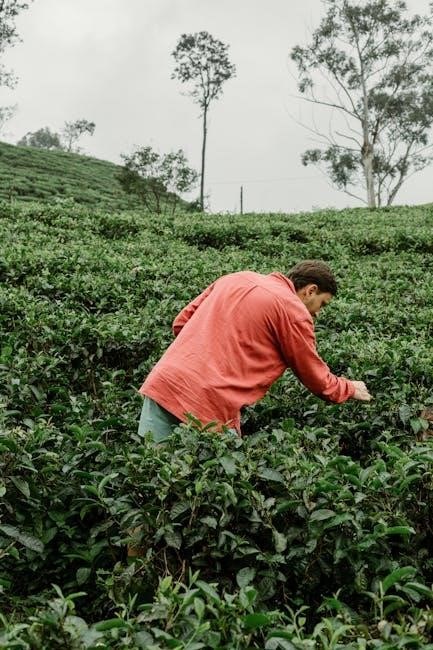
Health Benefits of Herbal Tea
Herbal tea offers numerous health benefits‚ aiding digestion‚ reducing stress‚ boosting immunity‚ improving skin health‚ and promoting restful sleep‚ all through natural‚ caffeine-free ingredients and antioxidants.
Aiding Digestion
Herbal teas are renowned for their digestive benefits‚ with many varieties soothing the stomach and alleviating common issues like bloating and indigestion. Peppermint tea‚ for instance‚ is well-known for its ability to relax the muscles in the digestive tract‚ easing cramps and improving the flow of bile‚ which helps in breaking down fats. Chamomile tea‚ on the other hand‚ is a natural anti-inflammatory that can calm an upset stomach and reduce inflammation in the digestive system; Ginger tea is another popular option‚ as ginger contains compounds like gingerol‚ which have natural anti-inflammatory properties and can help with nausea and indigestion. Additionally‚ herbal teas like fennel and dandelion root tea are known to support healthy digestion by stimulating appetite and aiding in the breakdown of nutrients. These teas are often consumed after meals to promote a smooth digestive process and prevent discomfort. Overall‚ herbal teas provide a natural and caffeine-free way to support digestive health.
Reducing Stress and Anxiety
Herbal teas are a natural and effective way to reduce stress and anxiety‚ offering a calming escape from the pressures of daily life. Chamomile tea is particularly renowned for its soothing effects‚ as it contains apigenin‚ an antioxidant that binds to GABA receptors in the brain‚ promoting relaxation and reducing anxiety. Lavender tea is another popular choice‚ known for its calming aroma and ability to ease tension. Lemon and ginger tea can uplift the mood and reduce stress due to their invigorating scent and natural anti-inflammatory properties. Hibiscus tea‚ with its cranberry-like flavor‚ is also known to lower blood pressure and create a sense of calm. Many herbal teas‚ like peppermint and rosehip tea‚ provide a refreshing and peaceful experience‚ helping to clear the mind and alleviate stress naturally. Incorporating these teas into your daily routine can be a simple yet effective way to manage anxiety and promote mental well-being.
Boosting the Immune System
Herbal teas offer a natural way to boost the immune system‚ providing essential nutrients and antioxidants to help the body fight off infections. Echinacea tea‚ known for its immune-boosting properties‚ is often consumed to prevent and alleviate cold and flu symptoms. Ginger tea‚ with its anti-inflammatory properties‚ supports the immune system by reducing inflammation and promoting overall well-being. Lemon and ginger tea combines vitamin C-rich lemon with ginger’s warming effects‚ creating a powerful blend to fortify the immune system. Additionally‚ elderberry tea is renowned for its high antioxidant content‚ which helps protect the body from free radicals and strengthen immunity. Regular consumption of these teas can contribute to a stronger immune system‚ reducing the risk of illnesses and enhancing the body’s natural defense mechanisms. Incorporating immune-supporting herbal teas into your daily routine can be a simple yet effective way to maintain long-term health.
Improving Skin Health
Herbal teas can significantly contribute to improving skin health by providing essential nutrients‚ antioxidants‚ and anti-inflammatory properties. Hibiscus tea‚ rich in vitamins and minerals‚ helps to purify the skin and reduce acne‚ while chamomile tea soothes irritations and calms conditions like eczema. Rosehip tea‚ high in vitamin C‚ promotes collagen production‚ enhancing skin elasticity and reducing signs of aging. Dandelion tea supports liver health‚ which is crucial for detoxification and clear skin. Calendula tea‚ with its antiseptic properties‚ aids in healing wounds and reducing inflammation. Regular consumption of these teas can help maintain a healthy‚ glowing complexion by addressing various skin concerns naturally. Incorporating herbal teas into your skincare routine can complement topical treatments and promote long-term skin well-being.
Aiding Sleep
Herbal teas are renowned for their ability to promote relaxation and improve sleep quality. Chamomile tea‚ with its soothing effects‚ is a popular choice for unwinding before bed‚ as it calms the mind and body. Lavender tea‚ known for its calming scent‚ helps reduce stress and anxiety‚ making it easier to fall asleep. Valerian root tea is another natural remedy that has been used for centuries to treat insomnia and restlessness. The natural compounds in these teas work to quiet the mind‚ lower stress hormones‚ and create a peaceful environment for sleep. Drinking herbal tea as part of a bedtime routine can signal the body that it’s time to rest‚ leading to deeper and more restorative sleep. Unlike caffeinated beverages‚ herbal teas promote relaxation without disrupting sleep patterns‚ making them an ideal natural solution for better sleep.
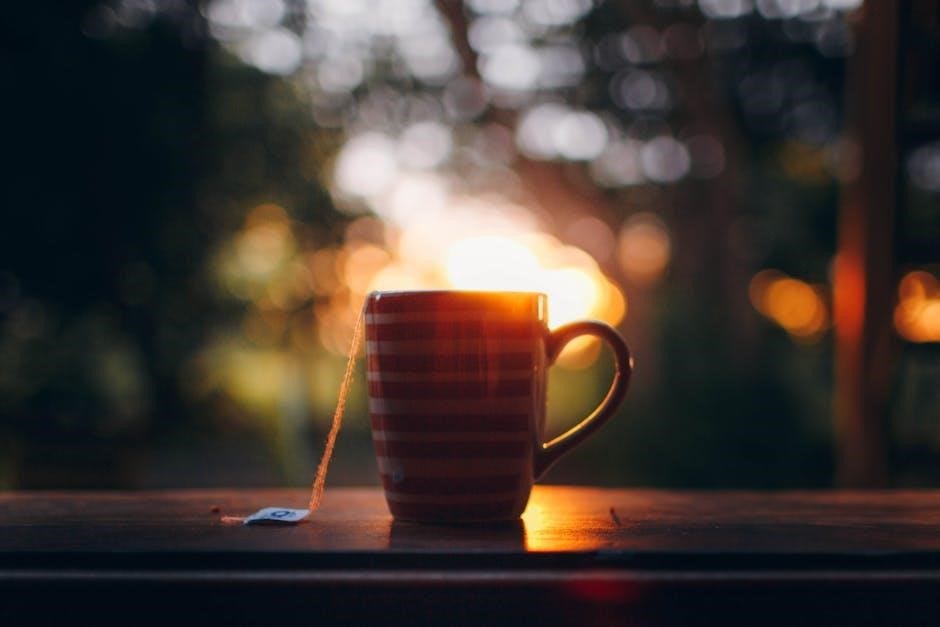
How to Make the Perfect Cup of Herbal Tea
Use filtered water‚ heat it to the right temperature‚ and steep for the recommended time. Covering the tea while steeping enhances flavor and aroma‚ ensuring a perfect brew.
Choosing the Right Ingredients
Selecting high-quality herbs‚ flowers‚ and spices is essential for a flavorful and therapeutic herbal tea. Opt for organic‚ fresh‚ or dried ingredients to ensure maximum potency and aroma. Consider the purpose of your tea—whether it’s for relaxation‚ digestion‚ or immune support—and choose herbs like peppermint‚ chamomile‚ or ginger accordingly. Fresh herbs can be grown at home or sourced from local gardens‚ while dried options are convenient and long-lasting. Store ingredients in airtight containers to preserve freshness and flavor. Experiment with single-herb teas or blends to discover your preferences. For sustainability‚ look for ethically sourced and eco-friendly packaging. Always check for allergies or sensitivities before trying new herbs‚ and consult a professional if needed. The right ingredients will elevate your tea experience‚ offering both taste and wellness benefits.
Water Quality and Temperature
Using fresh‚ filtered water is crucial for brewing herbal tea‚ as tap water may contain impurities that affect flavor and aroma. Avoid reheating water‚ as it can lose oxygen‚ which is essential for releasing the herbs’ full potential. Heat water to a rolling boil‚ typically around 200°F‚ depending on the herbs used. Delicate flowers like chamomile may require slightly cooler temperatures‚ while roots and spices like ginger can handle hotter water. Use freshly drawn water each time to ensure optimal oxygen levels‚ which enhance the tea’s flavor and aroma. For the best results‚ avoid using microwaved water‚ as it can unevenly heat and reduce oxygen content. Proper water quality and temperature balance are key to bringing out the unique characteristics of your herbal tea blend.
Steeping Time and Technique
The steeping process is vital for extracting the perfect balance of flavors and nutrients from herbal tea. Most herbal teas require a steeping time of 5 to 10 minutes‚ depending on the herbs used. Delicate flowers like chamomile or lavender should steep for 5-7 minutes to avoid bitterness‚ while harder ingredients like roots or spices may need up to 10-12 minutes. Use one teaspoon of dried herbs or one tablespoon of fresh herbs per 8 oz of water. Cover the cup during steeping to retain heat and essential oils. For loose-leaf teas‚ a tea infuser or strainer is recommended to keep the herbs contained. Stir gently after adding honey or milk‚ if desired‚ to ensure even distribution. Adjust steeping time based on personal preference for strength and flavor. Experimenting with times and temperatures helps achieve the perfect cup every time.
Popular Types of Herbal Tea
Herbal teas offer diverse flavors and benefits‚ with popular varieties including peppermint‚ chamomile‚ hibiscus‚ lemon balm‚ ginger‚ and lavender‚ each providing unique wellness properties and aromatic experiences.
Peppermint Tea
Peppermint tea‚ known for its cooling and refreshing flavor‚ is a popular choice among herbal tea enthusiasts. Derived from the leaves of the peppermint plant‚ it offers a invigorating aroma and taste. This caffeine-free option is celebrated for its digestive benefits‚ helping to alleviate bloating and indigestion. Peppermint tea also serves as a natural stress reliever‚ promoting relaxation and mental clarity. Its ability to improve focus makes it a favorite for those seeking a midday boost. Additionally‚ it is believed to support respiratory health and can be enjoyed hot or iced‚ making it a versatile choice for any time of day. With its soothing properties and versatility‚ peppermint tea remains a beloved selection in the world of herbal infusions.
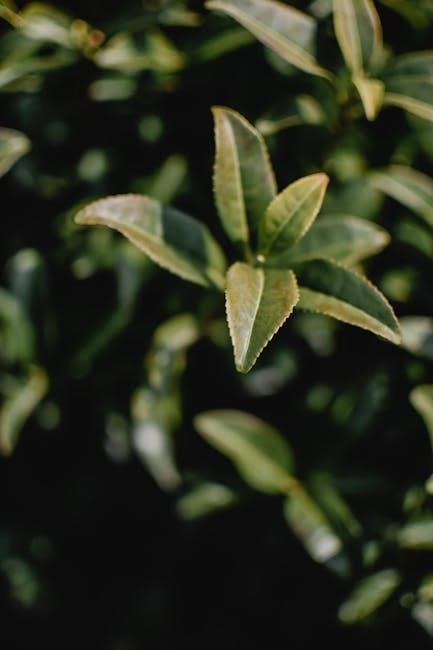
Chamomile Tea
Chamomile tea‚ crafted from the flowers of the chamomile plant‚ is renowned for its calming and soothing properties. This herbal infusion has been a timeless remedy for centuries‚ cherished for its ability to promote relaxation and reduce anxiety. Chamomile tea is often consumed before bed to aid in achieving a restful night’s sleep‚ as it helps unwind the mind and body. Its gentle‚ floral flavor makes it a comforting choice for those seeking tranquility. Additionally‚ chamomile is believed to have anti-inflammatory properties‚ potentially benefiting skin health and digestion. Many find solace in its warm‚ aromatic brew‚ making it a staple in herbal tea collections worldwide. Whether enjoyed for its therapeutic benefits or its delightful taste‚ chamomile tea remains a beloved and enduring option for those seeking calm and wellness.
Hibiscus Tea
Hibiscus tea‚ made from the vibrant flowers of the hibiscus plant‚ is a popular herbal infusion known for its striking red color and refreshing flavor. This caffeine-free tea has been a staple in many cultures‚ particularly in tropical regions‚ for centuries. It is celebrated for its potential health benefits‚ including high levels of antioxidants and vitamins. Hibiscus tea is often consumed for its ability to support blood pressure regulation and improve overall cardiovascular health. The tea’s cranberry-like taste is both tart and slightly sweet‚ making it a delightful choice for those who enjoy robust flavors. It can be enjoyed hot or iced‚ sweetened with honey or lemon for added zest. Hibiscus tea is also used in traditional medicine for its anti-inflammatory properties‚ further enhancing its appeal as a natural remedy. Its versatility and health-promoting qualities make it a favorite among herbal tea enthusiasts worldwide.
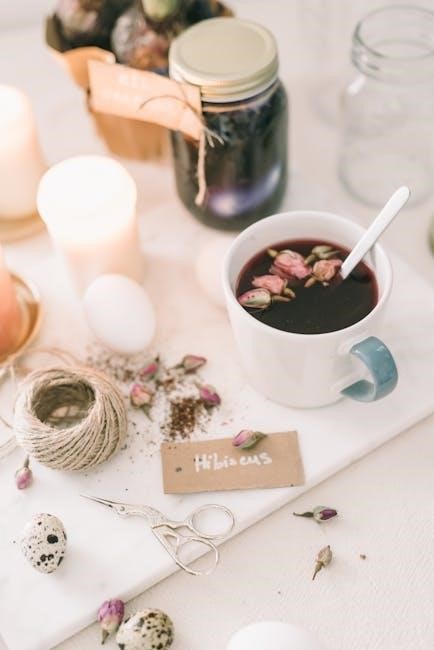
Herbal Tea and Gardening
Growing herbs for tea adds freshness and fragrance to your brews‚ allowing you to cultivate flavors like chamomile‚ peppermint‚ and lemon balm right in your garden‚ fostering a creative connection to nature.
Growing Your Own Herbs
Growing your own herbs for tea is a rewarding experience that ensures fresh flavors and fragrances. Start by selecting herbs like chamomile‚ peppermint‚ or lemon balm‚ which thrive in well-drained soil and partial sunlight. Plant seeds or seedlings in spring or fall‚ depending on your climate. Water regularly but avoid over-saturation to prevent root rot. Fertilize lightly during the growing season to enhance health and flavor. Prune herbs frequently to encourage bushy growth and prevent flowering‚ which can alter taste. Many herbs can also be grown in containers‚ making them ideal for small spaces or indoor gardens. Harvest leaves or flowers at their peak freshness‚ usually in the morning after dew evaporates. This practice not only provides a steady supply of tea ingredients but also connects you deeply with nature and the art of cultivation.
Harvesting Tips for Freshness
Harvesting herbs at the right time and in the right way is crucial for optimal flavor and aroma in herbal teas. For most herbs‚ the best time to harvest is early in the morning‚ after the dew has evaporated but before the heat of the day. Use clean‚ sharp tools to avoid bruising the leaves or flowers‚ which can lead to bitterness. Harvest leaves and flowers when they are at their peak freshness and fragrance‚ typically during the spring and summer months. Avoid harvesting herbs that have been exposed to pesticides or pollutants. After harvesting‚ gently rinse the herbs with cool‚ filtered water and pat them dry to remove excess moisture. Store them in airtight containers or immediately use them for tea to preserve freshness and potency.
Common Herbs to Grow
Growing your own herbs for tea can be a rewarding experience‚ and many popular varieties are easy to cultivate. Peppermint‚ chamomile‚ and lemon balm are favorites for their distinct flavors and benefits. Calendula‚ lavender‚ and hibiscus are also widely grown for their vibrant colors and therapeutic properties. Herbs like lemongrass and ginger thrive in warmer climates‚ while mint and sage prefer well-drained soil. Dandelion and nettle are excellent choices for their versatility and nutritional value. Planting these herbs in a sunny spot with good drainage ensures healthy growth. Regular pruning and proper care will keep your herbs flourishing‚ providing fresh ingredients for your tea blends year-round. Growing your own herbs allows you to enjoy the freshest flavors and the satisfaction of using homegrown produce in your teas.
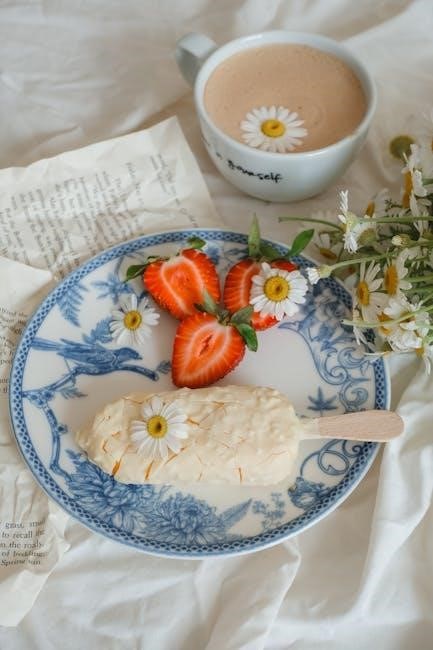
Blending Herbal Teas
Blending herbal teas is an art that combines diverse herbs‚ spices‚ and flowers to create unique flavors and enhance well-being. It allows for customization‚ catering to personal preferences and health goals‚ while experimenting with aromas and tastes to craft the perfect brew.
Creating Custom Blends
Creating custom herbal tea blends allows you to tailor flavors and health benefits to your preferences. Start by selecting a base herb‚ like peppermint or chamomile‚ and add complementary ingredients such as rose petals‚ ginger‚ or lemongrass for unique profiles. Experiment with spices like cinnamon or nutmeg to enhance warmth and aroma. Combine floral notes like lavender or hibiscus for a soothing‚ fragrant brew. Consider the purpose of your blend—whether it’s for relaxation‚ digestion‚ or energy—and choose herbs accordingly. For example‚ pair lemon balm with green tea for a refreshing‚ uplifting blend. Store your creations in airtight containers to preserve freshness. Blending is an art that encourages creativity and personalization‚ letting you craft the perfect cup every time. This process not only enhances flavor but also allows you to enjoy the therapeutic benefits of your custom-made tea.

Benefits of Blending Herbs
Blending herbs in herbal tea offers numerous benefits‚ enhancing both flavor and health advantages. Combining different herbs allows for a more complex and balanced taste experience. For instance‚ pairing spicy ginger with soothing chamomile creates a harmonious brew that calms the mind while invigorating the senses. Additionally‚ blending herbs can amplify their therapeutic effects. For example‚ lemon balm and echinacea together may boost the immune system more effectively than either herb alone. This synergy also allows for tailored health benefits‚ such as improving digestion or reducing stress. Furthermore‚ blending encourages creativity and personalization‚ enabling users to craft teas that suit their unique preferences and needs. This approach not only enriches the drinking experience but also maximizes the potential health benefits of herbal tea.
Tips for Successful Blending
Creating effective herbal tea blends requires careful consideration of flavor profiles and therapeutic properties. Start by selecting high-quality‚ fresh ingredients to ensure optimal taste and potency. Experiment with small batches to refine your blends before scaling up. Balance sweet‚ spicy‚ floral‚ and earthy notes to achieve a harmonious flavor. Consider the purpose of the blend—whether it’s for relaxation‚ energy‚ or digestion—and choose herbs accordingly. Document your recipes to replicate successful combinations. Taste as you go‚ adjusting proportions to suit your palate. For a smoother infusion‚ combine delicate herbs like chamomile with robust spices like ginger. Finally‚ store blends in airtight containers to preserve freshness and aroma. By following these tips‚ you can craft unique and satisfying herbal teas tailored to your preferences and needs.
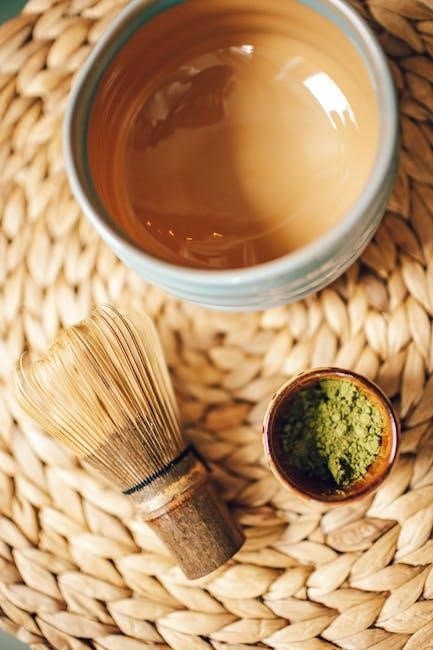
Pairing Herbal Tea with Food
Herbal teas complement sweet and savory dishes‚ enhancing flavors and creating a balanced dining experience. Pair peppermint with dark chocolate or chamomile with light meals for a delightful match.
Sweet Treats and Herbal Tea
Pairing herbal teas with sweet treats creates a delightful and refreshing experience. Peppermint tea‚ with its invigorating aroma‚ complements dark chocolate beautifully‚ while chamomile tea pairs nicely with honey-infused pastries. Lemon and ginger tea adds a zesty twist to citrus-based desserts like lemon bars or orange tarts. For floral notes‚ rosehip tea can be enjoyed with berry tarts or fruit salads. The subtle sweetness of hibiscus tea makes it an excellent match for caramel-based desserts or sweet biscuits. When selecting a tea to pair with sweets‚ consider the flavor profile: bold‚ spicy teas like ginger or cinnamon work well with rich desserts‚ while lighter‚ floral teas like rose or lavender complement delicate treats. This harmonious combination enhances both the tea and the dessert‚ creating a balanced and enjoyable experience for the palate.
Savory Dishes and Tea Pairing
Herbal teas can beautifully complement savory dishes‚ enhancing both flavor and dining experience. Peppermint tea pairs well with hearty soups or roasted vegetables‚ as its cooling effect cuts through richness. Chamomile tea‚ with its earthy undertones‚ complements herb-roasted poultry or fish dishes. Thyme tea‚ known for its robust and slightly minty flavor‚ pairs nicely with savory meat stews or grilled mushrooms. Lemon and ginger tea adds a citrusy zing that complements light‚ zesty salads or seafood. For robust dishes like hearty stews or game meats‚ consider rosemary tea‚ which enhances herbal notes in the food. Hibiscus tea‚ with its tart‚ cranberry-like flavor‚ pairs surprisingly well with rich‚ savory cheeses or charcuterie boards. Experimenting with these pairings can elevate your meals and introduce new dimensions to your culinary repertoire.
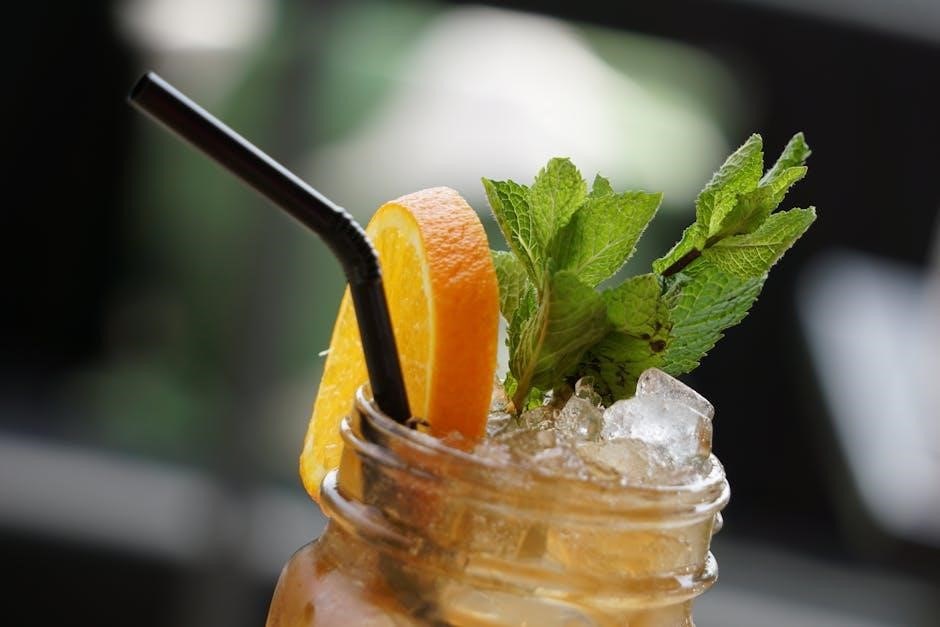
Herbal Tea Recipes
Explore refreshing herbal tea recipes like Lemon and Ginger Tea‚ boosting circulation‚ and Berry Bliss Tea‚ offering fruity‚ antioxidant-rich flavors. Customize blends for unique taste and wellness benefits.
Lemon and Ginger Tea Recipe
A refreshing and invigorating blend‚ Lemon and Ginger Tea is perfect for boosting circulation and uplifting your senses. Ingredients include fresh ginger (sliced thinly)‚ lemon slices‚ and honey for sweetness. Instructions: In a large pot‚ bring 4 cups of filtered water to a boil. Add 1-inch fresh ginger‚ sliced‚ and simmer for 5-7 minutes. Remove from heat‚ add lemon slices‚ and let steep for 3-5 minutes. Strain into cups‚ add honey to taste‚ and serve hot. This tea is known for its ability to enhance circulation and provide a natural energy boost. The combination of ginger’s spicy warmth and lemon’s citrus zing creates a balanced flavor that’s both soothing and revitalizing. Enjoy it as a morning pick-me-up or an afternoon refreshment.
Berry Bliss Tea Recipe
Berry Bliss Tea is a delightful and nutritious infusion that combines the sweetness of berries with refreshing herbal notes. Ingredients include 2 tablespoons of mixed dried berries (such as blueberries‚ raspberries‚ and strawberries)‚ 1 tablespoon of rose hips‚ and 1 lemon slice. Instructions: In a teapot‚ steep the dried berries and rose hips in 2 cups of boiling water for 5-7 minutes; Strain into a cup‚ add a squeeze of fresh lemon juice‚ and sweeten with honey if desired. This tea is rich in antioxidants and vitamins‚ offering a fruity and uplifting flavor. Perfect for a cozy evening or a rejuvenating pick-me-up‚ Berry Bliss Tea is a vibrant way to enjoy the health benefits of berries while savoring a soothing brew.
